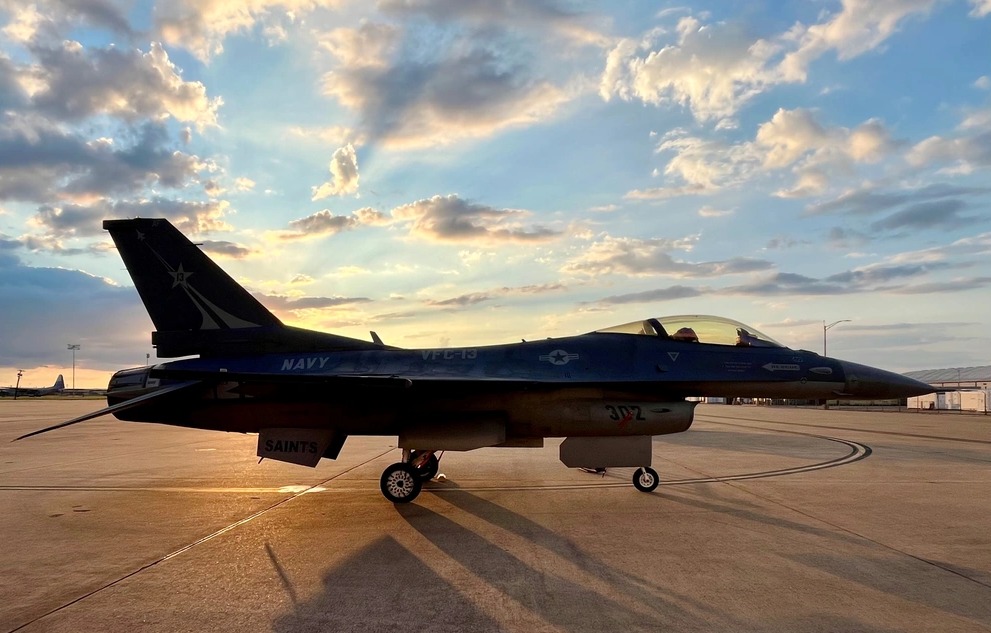US Navy Reveals Unsuccessful Bid To Acquire F-16 Fighting Falcons From Greece For ‘Adversary Squadrons’

In a surprising development, the US Navy recently revealed for the first time that it previously tried to acquire second-hand F-16 fighter jets from Greece without any success.
The revelation came through a press release issued on September 5, which also highlighted a major advancement for the Navy Reserve’s Fighter Squadron Composite (VFC)-13.
Based at Naval Air Station (NAS) Joint Reserve Base (JRB) Fort Worth, Texas, VFC-13 added a new F-16 Fighting Falcon to its fleet on August 27. This marks a pivotal upgrade for the squadron, which is tasked with replicating enemy air threats to train active-duty forces.
Commander Traver Fordham, the Executive Officer of VFC-13, provided insight into the acquisition process. According to Fordham, the Navy initially sought to purchase F-16s directly from Greece. However, the acquisition faced complications, leading the Navy to adapt its strategy.
“After encountering issues with buying from Greece, we capitalized on the Air Force’s plan to retire over 30 F-16s with 2,000 to 3,000 flight hours remaining,” Fordham explained.
AfriPrime App link: FREE to download...
https://www.amazon.com/Africircle-AfriPrime/dp/B0D2M3F2JT
Fordham added, “This led to a successful transfer agreement, and the first of these 26 F-16s, 12 of which went to VFC-13, was delivered to NAS Fallon back in April 2022, with plans to receive a total of 30.”

Fordham highlighted the necessity for additional jets to replace the aging fleet of F/A-18A-to-D Hornets. Only 12 F/A-18E/F Super Hornets were made available to replace approximately 48 ‘legacy’ Hornets, as the production run concluded earlier than anticipated.
The Navy’s decision to accelerate the withdrawal of its older F/A-18A-D Hornets—prompted by high operating costs and an expedited production timeline—left a significant gap in adversary air capabilities.
The transition from these legacy Hornets to new-generation adversary aircraft also highlights the Navy’s commitment to maintaining effective and realistic training environments.
The F-16s are expected to bring considerable advantages over the older F-5N Tiger IIs previously used. With their advanced avionics and high-performance capabilities, the F-16s are well-suited to replicate sophisticated adversaries during dissimilar air combat training, providing more realistic and challenging scenarios for active-duty forces.
Fordham noted that newly built F-16s were deemed too expensive and time-consuming. As a result, the Navy explored second-hand options, leading to negotiations with Greece.
Reports indicated that Greece was looking to sell its Block 30 F-16s as they are now outdated compared to the country’s newer F-16 variants.
Greece’s available aircraft likely included some of its oldest jets—34 single-seat F-16Cs and six two-seat F-16Ds from the Block 30 series, which were delivered between 1988 and 1990 under the Peace Xenia I program.
AfriPrime App link: FREE to download...
https://www.amazon.com/Africircle-AfriPrime/dp/B0D2M3F2JT
These Block 30 jets are part of the 330 Mira squadron and have undergone the Falcon UP service-life extension, providing them with some remaining flight hours.Despite the Navy’s efforts, the acquisition from Greece faced “difficulties,” as outlined in the media release. The exact reasons behind the inability to secure the Greek jets remain unclear, leaving some questions unanswered regarding the challenges.
The Evolution of Navy F-16 Adversary Operations
The US Navy’s history with the F-16 Fighting Falcon is a tale of evolution and ongoing excellence in adversary operations. The journey began in the mid-1980s with the introduction of the F-16N, a specialized version designed to mimic high-end Russian fighters.
This iteration of the F-16, derived from the F-16C/D Block 30, was equipped with the older AN/APG-66 radar from the F-16A/B and featured a reinforced, lightweight airframe. The removal of the M61A1 cannon further reduced its weight, enhancing its agility.
Despite its impressive performance, the F-16N was retired in the mid-1990s due to metal fatigue resulting from the intense demands of air combat maneuvering.
Following the retirement of the F-16N, the Navy acquired 14 F-16 Block 15 OCU aircraft. These planes were originally built for Pakistan but were embargoed and subsequently stored at Davis-Monthan Air Force Base, Arizona.
The fleet included eight single-seat F-16As and six two-seat F-16Bs, which were repurposed for adversary training roles within the Navy.

Meanwhile, in recent years, the Navy has intensified its efforts to bolster its F-16 adversary fleet, particularly to address the gap left by the retirement of legacy Hornet aircraft.
In 2021, the Navy announced that it would receive 20 F-16C Block 32 aircraft and six F-16D Block 25 fighter jets from the US Air Force. This acquisition was a major step in enhancing the Navy’s adversary capabilities.
Of these 26 F-16s, 12 have been assigned to VFC-13, specifically from the F-16C models, according to the Navy. Homeported at Naval Air Station Fallon, Nevada, VFC-13 plays a pivotal role in adversary training.
The squadron provides essential training for Navy and Marine Corps active and reserve fleet squadrons, carrier air wings, Marine aircraft groups, and Air Force units.
In November 2022, VFC-13 received its first F-16, replacing its previous fleet of F-5Ns. By 2023, VFC-13, the Navy’s premier adversary squadron, marked a milestone by completing its first Strike Fighter Advanced Readiness Program (SFARP) solely with F-16s.
This achievement was coupled with the squadron’s declaration of Safe-for-Flight status. With the latest addition, the Tactical Support Wing’s fleet now comprises 13 F-16s, significantly bolstering its capacity to train naval aviators and enhancing its overall warfighting capabilities.
VFC-13’s F-16s are adorned with diverse paint schemes to effectively simulate various enemy aircraft in Dissimilar Air Combat Training (DACT) sessions.
These paint schemes reflect the broad spectrum of adversary aircraft they are tasked to represent, enhancing the effectiveness of training exercises.
AfriPrime App link: FREE to download...
- Questions and Answers
- Opinion
- Motivational and Inspiring Story
- Technology
- Live and Let live
- Focus
- Geopolitics
- Military-Arms/Equipment
- Seguridad
- Economy
- Beasts of Nations
- Machine Tools-The “Mother Industry”
- Art
- Causes
- Crafts
- Dance
- Drinks
- Film/Movie
- Fitness
- Food
- Juegos
- Gardening
- Health
- Home
- Literature
- Music
- Networking
- Other
- Party
- Religion
- Shopping
- Sports
- Theater
- Health and Wellness
- News
- Culture

